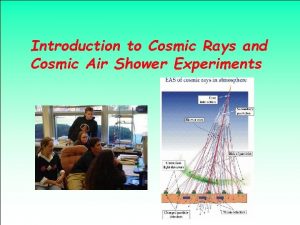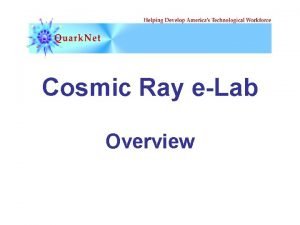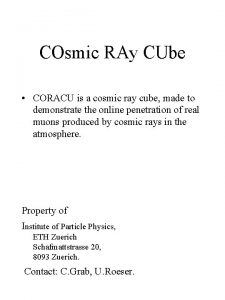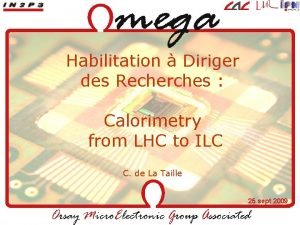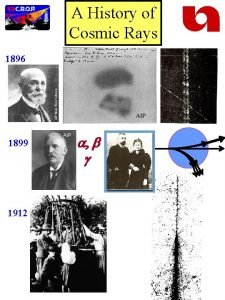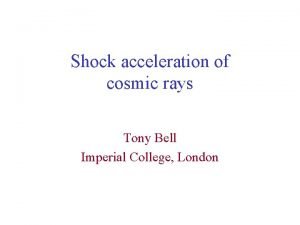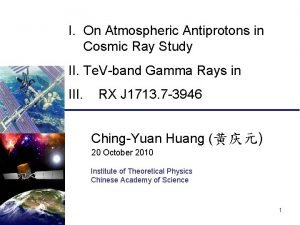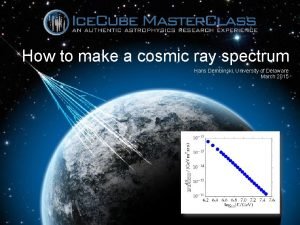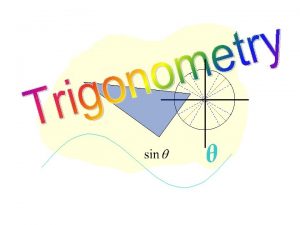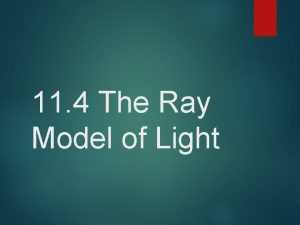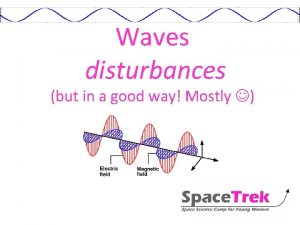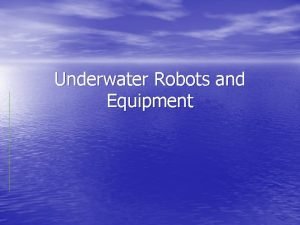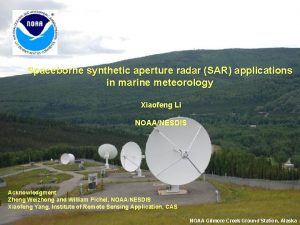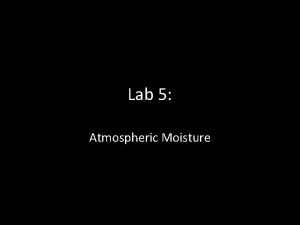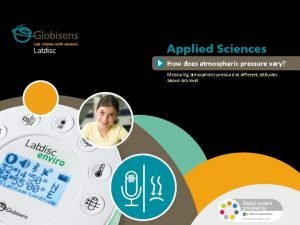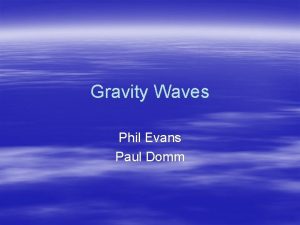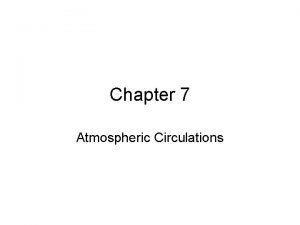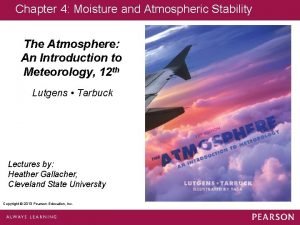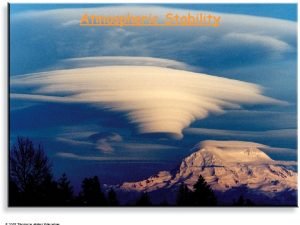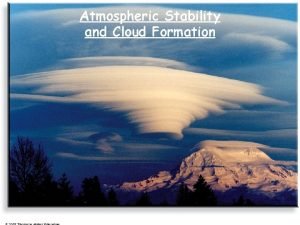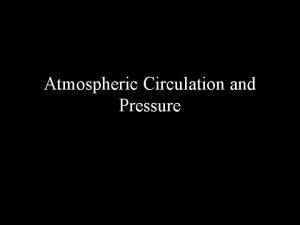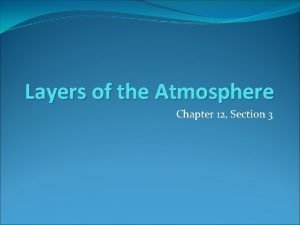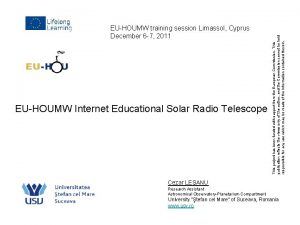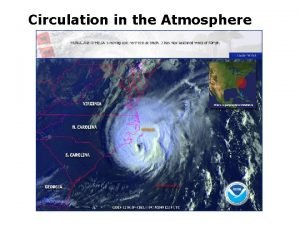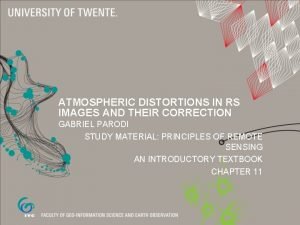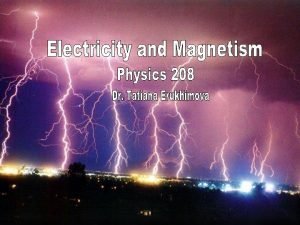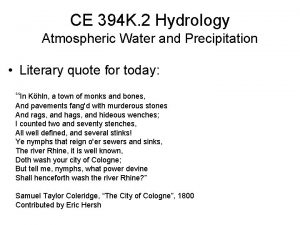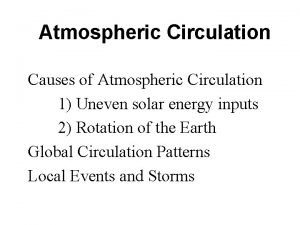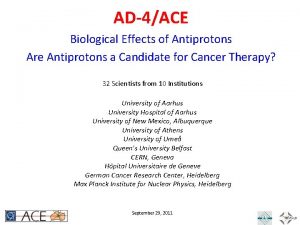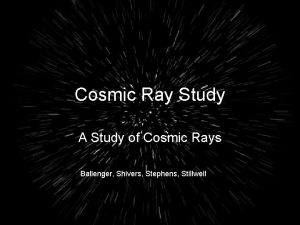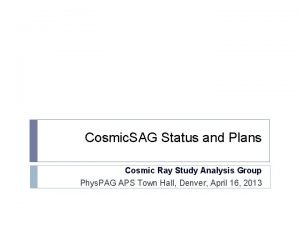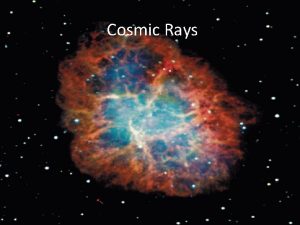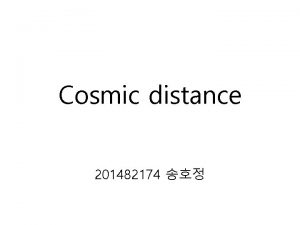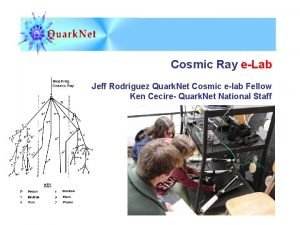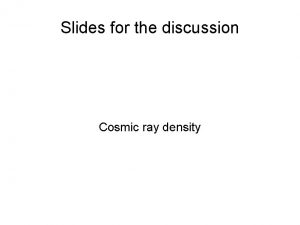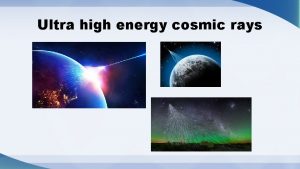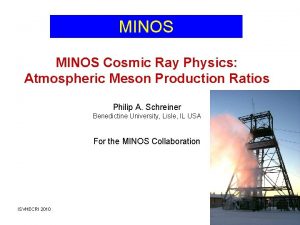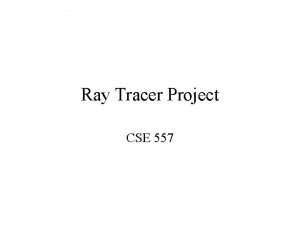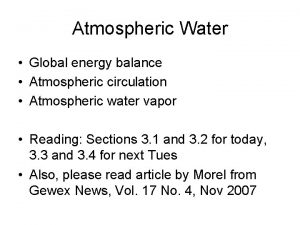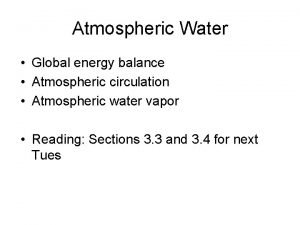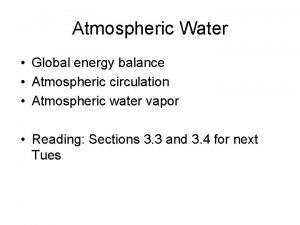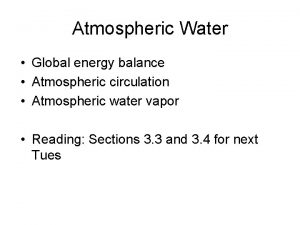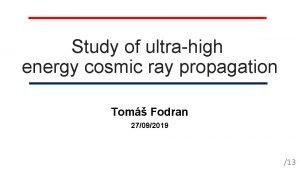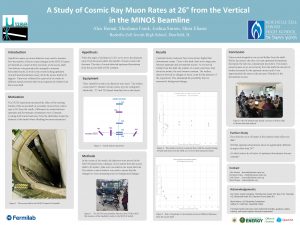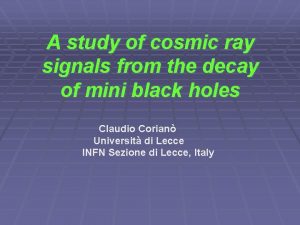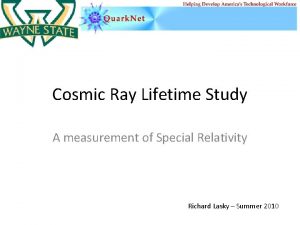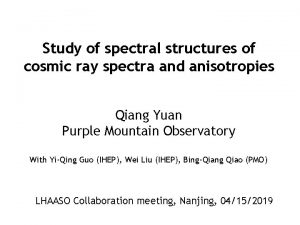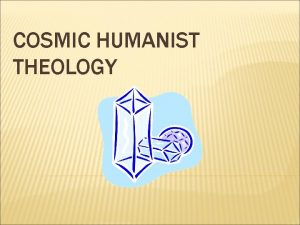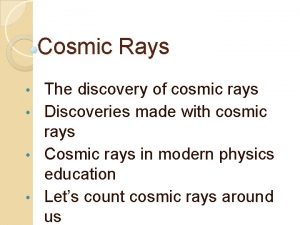I On Atmospheric Antiprotons in Cosmic Ray Study



































- Slides: 35

I. On Atmospheric Antiprotons in Cosmic Ray Study II. Te. V-band Gamma Rays in III. RX J 1713. 7 -3946 Ching-Yuan Huang (黄庆元) 20 October 2010 Institute of Theoretical Physics Chinese Academy of Science 1

Section I: Cosmic Rays 2

Something about Cosmic Rays • High energy charged particles arriving at Earth from outer space - Discovered in 1912 Natural source for new particle discovery (until 1953) Energy: 108 e. V (100 Me. V) to 1020 e. V (100 Ee. V) Time scale contained in galaxy: can be as long as 1010 years Messenger of non-thermal Universe • Interest: -origin: Supernova Remnants? Black Holes? Dark Matters? Pulsar? Active Galactic Nuclei? . . . - acceleration: B field? shock acceleration? . . . - transport/interaction 3

Cosmic Ray Composition and Spectrum Solar Modulation • cosmic ray compositions: - 86% p; 12% α - 2% e - 1 % C, N, O, Li, Mg, Si, Fe nuclei - small amount of (~ p) • Cosmic Ray (CR) Spectra (200 Te. V) (simple power law) Non-thermal! 4

3 Regimes in Cosmic Ray Spectrum • regimes in CR spectrum knee ankle GZK cutoff 5

Cosmic Rays in Galaxy z halo ⊙ r disc halo • diffusion process in large scale halo under galactic magnetic irregularities; • physics involved: production, (re)-acceleration, energy loss, decay, interaction, convection, diffusion, escape, fluctuation. . . 6

Cosmic Rays in Solar System and Earth Both against low energy cosmic rays! 7

Allowed/Forbidden Regions (shaded: forbidden; white: allowed) • critical case: b (impact parameter) = -1, allowed regions linked • Geomagnetic cutoff arises from Earth magnetic field! 8

Cosmic Rays in Earth Atmosphere unique technique for detection of cosmic-ray particles with E > 200 Te. V, due to detector limitation! 9

Section II: Atmospheric Antiprotons 10

Why Antiprotons/Atmospheric Antiprotons? • interest of origin (discovered in 1979) - galactic origin: secondary product from interactions between cosmic rays and interstellar medium (called galactic, galactic secondary) Not abundant enough to explain the exp. detections! • possible exotic origin: - annihilation of SUSY Dark Matter (Neutralino χ) - evaporation of Primordial Black Holes (PBH) 11

Antiproton Spectra from Different Sources ID window by Peak at 2 Ge. V (SUSY model for Ge. V ) SUSY DM and PBH identification window exists in window E< 1 Ge. V! 12

Challenge for Cosmic Antiproton Detection • measured antiprotons in Earth experiments are actually a composition exp. measured 2 nd atmospheric 2 nd Galactic cosmic primary SUSY Correction of atmospheric antiprotons onto experiments is absolutely required! PBH 13

Schematics of Simulation Model 1) Cosmic Ray distribution (natural abundance); incoming particle propagation in Earth magnetic field 3) Propagation of secondaries 4) Counting when crossing orbit altitude ↑and ↓ plan e geomagnetic field line rial bit Model of Atmosphere Equ ato Po le or AM S 2) Interaction CR+A→n±, p±+X… 5) End of propagation: escape, collision/slowing down/absorbed… 14

Antiproton Experiments and Altitudes 400 km to measure pure cosmic antiproton flux (i. e. , no atmospheric component) AMS (Discovery ST 591) Ans: quite doubtful! 40 km 3 km to measure antiproton flux at Top of Atmosphere (TOA) mountain level exp. very unusual (BESS ’ 99 exp. )! 15

Antiproton Flux at TOA by Balloon Exp. BESS ’ 98@38 km CR He contribution CAPRICE ’ 98@36 km CR He contribution (Huang ’ 03 PRD) Good agreement with previous calculations! 16

Antiproton Flux Measured by AMS • Atmospheric correction is always needed, even for space experiments! • pure (nearly) measurement possible only in (sub)polar regions! • upward/downward particles compatible. Why? AMS@400 km (Huang ’ 03 PRD) 17

Integrated Antiproton Flux • At balloon altitudes, only ↓particles can be detected! (totally detector effect) • At space altitudes, ↓and ↑ charged particles are of the same order, unless in (sub)polar regions. Existence of trapped/quasitrapped charged particles in Earth magnetic field! 18 (on AMS acceptance) (Huang ’ 03 PRD)

Charged Particle Trajectory in Earth Multipole (Huang ’ 03 PRD) • particles in low latitude regions with extremely complicated trajectories, contributing large crossing multiplicity! • Particles at high altitudes or with high kinematics can be 19 trapped by Earth!

Antiproton Measurement at Mountain Level 400 km • Flux magnitude at this level is small but still detectable by current exp. detectors. • Antiprotons are purely atmospheric at such altitudes. 40 km 3 km • good probe to test cosmic-ray transport model! • Result was confirmed by BESS 1999 experiment! (Sanuki, ’ 03 PLB) 20

Antiproton Flux at Mountain Level • discrepancy from data in other models usually used (Bowen ’ 86; Stephens ’ 93) • result confirmed by BESS exp. ! (Huang ’ 03 PRD, Huang ’ 07 Astropart. Phys. ) 21

Section II: Te. V-band Gamma Rays of RX J 1713. 7 -3946 22

Gamma-Ray Astrophysics • probe of the non-thermal Universe • neutral in charge, high penetrating nature of emissions, as a powerful tool to study cosmic-ray sources in γ-ray domain • Broad waveband γ-ray observation presents clear physical characters: - Synchrotron - Bremsstrahlung - hadronic interactions (and decays) - Inverse Compton Scattering 23

Gamma-Ray Astrophysics (Ultimate Purpose) • understand cosmic-ray origin, acceleration, propagation… understand the γ-ray background (Big Bang, DM, CMB…) Need to unmask the γ-ray foreground! (γ-ray foreground: cosmic-ray source emissions, diffuse radiation in transport…) 24

γ Induced Air Shower Observed at Ground 25

RX J 1713. 7 -3946 Observation • young shell-type SNR → study cosmic-ray time evolution near source • dense molecular gas along line of sight → test for hadronic/leptonic model for cosmic-ray acceleration (HESS ’ 06) • X-ray time variability → study SNR magnetic field strength 26

Te. V-Band Spectrum of RX J 1713. 7 -3946 • Leptonic models (bremsstrahlung or Inverse Compton) requires unusually weak magnetic field! • Data with E ~ Me. V to 10 Te. V is needed for the puzzle! 27

Best Fitted Spectrum of RX J 1713. 7 -3946 • HEP event generator to simulate full picture of cosmic-ray hadronic interactions • considered full picture of γ -ray decays = 22. 4 for 22 DOF (-) spectral curvature strongly suggested (with CL > 95%)! (Huang et al. , ’ 07) 28

Shock Modification for Cosmic Rays • non-linear shock modification arises due to the dynamical reactions of accelerated particles on the shocks • Models predict continuous hardening spectra with a (+) spectral curvature! (Amato & Blasi ’ 06) (Ellison et al. , ’ 00) 29

X-Ray Emission Variability in of RX J 1713. 7 -3946 (2000) Chandra Observation (2005) (2006) (Uchiyama et al. , ‘ 07) • unique information of magnetic field in particle acceleration region! • Rapid variability implies shorter timescales and amplification of B field in SNR shell. 30

Synchrotron Radiation of RX J 1713. 7 -3946 • full picture of e-/e+ production and decays in CR interactions • more severe limits on B, α; • The non-thermal X-ray emission must originate from primary e-/e+! • multi-m. G field only possible with very limited fraction! (Huang et al, ’ 08) 31

Cosmic-Ray Neutrinos • background for ν Astrophysics • tool to study on CP-violation (neutrino oscillations) in Standard Model (atmospheric ν anomaly…) • accompanied product of hadronic γ-rays Neutrinos as the supplement tool to study hadronic and leptonic scenario in cosmic-ray particle origin/acceleration! 32

-Induced μ Rate of HE γ-Ray Sources • Ice. Cube-like detector assumed • ν full mixing assumed: experiment with data accumulation over 5 -10 yrs at Eμ~ few Te. V, or Eν ~ 10 Te. V to test hadronic origin of Te. V γ-rays! (Huang et al, ’ 08) 33

Summary on Atmospheric Antiprotons • a tool allowing to calculate the proton and atmospheric antiproton flux in the Earth environment: - developed antiproton production cross section in pp and p. A collisions; - shown the atmospheric antiproton correction is always required; - model agreed with proton flux from sea level to TOA • Antiprotons at low altitudes provides a tool to verify models and calculations. • approved understanding of particle dynamics in Earth environment 34

Summary of Te. V Gamma Rays • • • easy-to-use production matrices for cosmic ray interactions and decays; favored in hadronic model for SNR such as RX J 1713. 7 -3946 no evidence for standard models of CR modified shock accelerations; γ-ray data with energy E: Ge. V~ Te. V is needed to test cosmicray acceleration model; the multi-m. G magnetic field proposed for X-ray flux variations is very limited in RX J 1713. 7 -3946 proposed a promising experiment with data accumulation over 5 -10 years at E(μ)~ few Te. V, or E(ν) ~ 10 Te. V, to test origin of Te. V γ-rays 35
 Cosmic air flights
Cosmic air flights Cosmic ray elab
Cosmic ray elab Cosmic ray cube
Cosmic ray cube Bit flip cosmic ray
Bit flip cosmic ray Cosmic ray
Cosmic ray Cosmic ray spectrum
Cosmic ray spectrum Cosmic waves
Cosmic waves Cosmic ray
Cosmic ray Quadrants of sin cos tan
Quadrants of sin cos tan Ray ray model
Ray ray model Ray casting algorithm
Ray casting algorithm Atmospheric opacity
Atmospheric opacity Aerial perspective landscape painting
Aerial perspective landscape painting Atmospheric diving system
Atmospheric diving system Atmospheric gravity waves
Atmospheric gravity waves Penn state atmospheric science
Penn state atmospheric science Lab 5 atmospheric moisture
Lab 5 atmospheric moisture Air pressure at different altitudes
Air pressure at different altitudes Forceparcel
Forceparcel Single cell model of atmospheric circulation
Single cell model of atmospheric circulation Atmospheric stability
Atmospheric stability Define unstable equilibrium
Define unstable equilibrium Conditionally unstable atmosphere
Conditionally unstable atmosphere Circulates air between 60-90 latitudes
Circulates air between 60-90 latitudes Atmospheric heaven
Atmospheric heaven The four main layers of the atmosphere
The four main layers of the atmosphere Atmospheric opacity
Atmospheric opacity Atmospheric circulation
Atmospheric circulation Atmospheric distortion correction
Atmospheric distortion correction What is a weather variable
What is a weather variable Atmosphere layers definition
Atmosphere layers definition Atmospheric convection
Atmospheric convection Dr tatiana erukhimova
Dr tatiana erukhimova Atmospheric convection
Atmospheric convection Atmospheric convection
Atmospheric convection Atmospheric convection
Atmospheric convection
